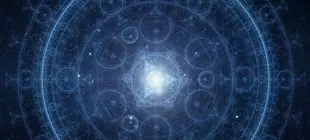To draw up a birth chart or astral forecast, astrologers use a map of the heavens. They then interpret the chart by analysing the position of the planets in the different constellations.

At the moment we are born, we all have our own individual astral chart. In order to interpret this, we need to know the exact position of the stars at the time of our birth.
To analyse a person's birth chart, it is necessary to understand the different aspects between the planets. In astrology, an aspect is calculated according to the number of degrees of the angle between two planets. A planet is said to be in aspect when it forms a particular angle to another or to a sensitive point in the astral chart. Some angles are positive and others are negative. These angles are very important in understanding the interplay of positive and negative influences affecting the potential of each planet.
The Conjunction
A conjunction is when two planets are less than 10° apart or 10° from an "angle" (the Ascendant or the Midheaven). The influences of the planets concerned are combined, harmonised or at loggerheads depending on the individual case, but a conjunction is always a very important aspect, especially if it receives aspects from elsewhere in terms of a square, sextile, trine or opposition.
The positive or negative influence of a conjunction also depends on the planets concerned. Depending on the nature of the planet, benevolent and expansive (like Venus or Jupiter), or rigid and restrictive (like Saturn or Pluto), the conjunction will highlight or cast a shadow over the planet's potential or over the angle formed by the aspect. It is particularly important to understand the nature of the conjunction, because the information gleaned here can greatly help a person to handle this powerful influence, in order to benefit from its force without ill effects.
Example: Leonardo di Caprio has a collection of conjunctions in his birth chart, which give a powerful focus to his talent. Without any doubt, the greatest is the close conjunction (less than 1°) between the Sun and Venus in Sagittarius and his Third House. This aspect has endowed him with great charisma. He has a genuine need to love and be loved, while at the same time having a particular gift for expressing his feelings and emotions. This conjunction is generally an indicator of great artistic and creative flair.
The Opposition
Planets are said to be in opposition when they are in opposing signs, in other words at an angle of 180° from one another, with a tolerance (or orb) of 10°. An opposition aspect dynamically reinforces the respective energies of each planet, which would appear to be antagonistic, but actually often complement each other.
Each of these planets tries to influence the other and will alternately have the upper hand. This mechanism of alternating contradictory influences can create psychological instability in the person concerned, feeling torn between these two tendencies. However, with maturity, these tensions can become a plus-point for those who know their own weaknesses and they will manage to tame these energies, which will ultimately complement each other.
The Trine
The trine is a positive aspect concerning two planets that are separated by an angle of around 120° (4 signs), with a tolerance of 8°. These planets are in signs belonging to the same element, making them compatible and mutually supportive.
Trine aspects are therefore formed between:
- Aries, Leo and Sagittarius
- Taurus, Virgo and Capricorn
- Gemini, Libra and Aquarius
- Cancer, Scorpio and Leo
This aspect is a sign of mental stability, but it also tends to favour an element of laziness, as it can make things too easy. If you don't question yourself too much, you don't improve. The trine is generally a symbol of an individual talent that still needs to be developed and used for moving forward in life.
The Sextile
The sextile is a positive aspect concerning two planets that are separated by an angle of around 60° (2 signs), with a tolerance of 4°. These planets exchange energies and work in perfect harmony. They symbolise exchange and communication.
This aspect creates opportunities, coincidences, lucky chances and good fortune, all of which reinforce individual potential. The sextile encourages success and communication with others. It augurs well for dialogue.
The Square
The square is a negative aspect concerning two planets separated by an angle of around 90° (3 signs), with a tolerance of 8°. This is an aspect that will block or exaggerate a personality trait.
This aspect causes conflict and dissension between two energies that are unable to work together and they restrict and hold each other back. To combat this tension, the person needs to battle against his/her difficulties, which requires a great deal of energy. However, this battle will not be to no avail, but will help to make us stronger. This aspect reinforces our energy, giving us the courage to fight on and put up resistance. Those who have this aspect in their birth chart will show tenacity and creative flair in resolving their problems.
As well as these five major aspects, there are also aspects said to be "minor", which are useful to know in order to be able to analyse a birth chart with accuracy. These minor aspects add further detail.
The quincunx is a positive aspect concerning two planets separated by around 150° (5 signs), with a tolerance of 2°. This is an alliance of two energies. Depending on the two planets in question, this aspect can mean that the two planets are either in conflict or they complement each other.
- The quintile is a mixed aspect, concerning two planets separated by an angle of around 72°, with a tolerance of 2°. This aspect is associated with a desire to change things using your own talents.
- The bi-quintile is also a mixed aspect, concerning two planets separated by an angle of around 144°, with a tolerance of 2°. Its influence is similar to the quintile's but somewhat softened.
- The semi-square is a negative aspect concerning two planets separated by around 45°, with a tolerance of 2°. This aspect resembles the square, but its effect is psychological, rather than concrete, and its influence is less restrictive.
- The semi-sextile is a negative aspect concerning two planets separated by around 30° (in adjacent signs), with a tolerance of 2°. Its effect is similar to the sextile's but less obtrusive.
- The sesquare is a negative aspect concerning two planets separated by around 135°, with a tolerance of 2°. The sesquare is a combative aspect involving tension, but one that enables you to move forward.
To draw up an accurate birth chart, it is important to take account of each aspect. Whether they are major or minor, they all need to be taken into consideration. These aspects are used in drawing up the birth chart of an individual or establishing the emotional compatibility between two partners.
Tensions in a birth chart are not to be interpreted in the same way as in a comparison between two charts. In the comparison between two charts, an opposition is interpreted as positive. They often complement each other.
However, in their forecasts, astrologers only use the major aspects.
Sometimes, one planet can turn out to be in an isolated position in the chart. This is known as an unaspected planet, as it has no aspects to any others. This kind of situation is quite unusual, but when it does occur, it leaves the person totally free to act according to his/her own instincts in the area ruled by the unaspected planet. The potential created by this type of planet requires a partner for whom the same planet receives many aspects. This person will compensate for the lack of aspects by passing on his/her overwhelming energy.






